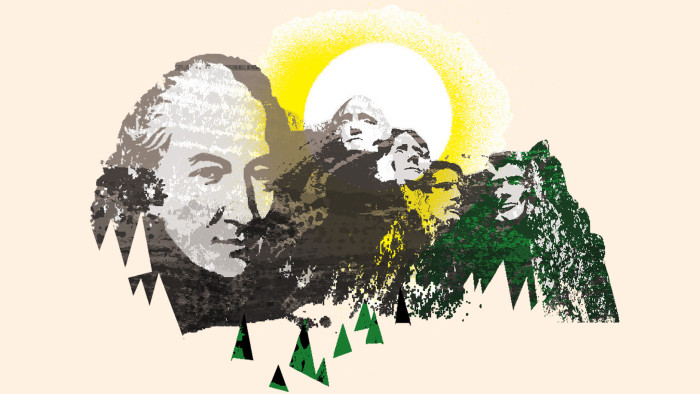America’s lost revolutionary


Roula Khalaf, Editor of the FT, selects her favourite stories in this weekly newsletter.
A few years ago David Lefer, a high school and college history teacher in Brooklyn, was asked by a student for a good book on John Dickinson, an 18th-century American Revolutionary political figure who hailed from Philadelphia.
Lefer duly scoured the libraries and discovered a striking fact: although America’s academic world is brimming with accounts of the Founding Fathers, there was almost nothing at all written on Dickinson. That struck Lefer as odd. Dickinson was important in that 18th-century independence movement, since he (in)famously penned the tracts known as Letters from a Farmer in Pennsylvania, which eloquently defended the idea of liberty and freedom.
Indeed, that writing was so influential that during Dickinson’s own lifetime he was considered “the most trusted man in America and second most famous American in the world, after Benjamin Franklin” and credited with “single-handedly rallying the colonies in the fight against British oppression”, as Lefer notes. And yet, by the 21st century, Dickinson’s name had slipped out of view.
So Lefer started digging into this curious silence, and earlier this month he published the fruits of this research in a book entitled The Founding Conservatives: How a Group of Unsung Heroes Saved the American Revolution.
This makes fascinating reading, and not just for history buffs or diehard American patriots. For Lefer argues that the lack of books about Dickinson is not just an oversight, but reflects a wider distortion in how modern Americans perceive their revolution. More specifically, in recent decades, schools have tended to teach that the revolt against the British was organised by a fairly united band of noble freedom fighters with shared, egalitarian views.
However, Lefer argues, this is wrong. In reality, the revolutionaries were racked by bitter infighting between a group that might be dubbed “liberals” (in that they held quite leftwing ideas and were low-born) and “conservatives” (who were of the elite and determined to protect their privileges against others).
Dickinson, who was a wealthy Maryland-born lawyer, fell into this latter camp. “These [elitists] were not loyalists [to the crown] … they were committed Patriots who nonetheless wanted to preserve as much of the old social order as possible,” Lefer writes, pointing out that the elite also had “faith in history and experience … support for venerable social institutions … reverence for the military … insistence on protecting property over equality … belief in yoking the interests of the rich and powerful to the government … and devotion to free-market capitalism”. In short, they were “revolutionary conservatives” whose ideas are echoed in the Republican party today.
Yet in the period after the second world war – when many modern history books were written – historians did not want to focus on this split or those elites. “With the United States facing an existential and ideological threat from Soviet Communism, the ‘consensus’ school … deliberately emphasized Americans’ underlying unity during the revolution … and believed that American history was fundamentally liberal.” So those Founding Fathers were presented as a happily unified group and Dickinson slipped from view.
Does this matter today? Lefer thinks it does. For one thing, Dickinson’s tale shows that the roots of modern conservatism run deeper in America than is commonly believed. However, it also shows that 18th-century conservatives were a pragmatic bunch, who could accept bipartisan compromise and adapt to changing social mores to win popular support. This is a trait that the modern Republican party badly needs to relearn, observes Lefer (who says that he is a Democrat, but gained a new respect for conservatism by studying Dickinson).
…
But, in my view, there is another lesson to draw as well: the slippery nature of historical “truth”. As I have noted in a recent column, history occupies a strikingly large place in school curriculums in America, compared with a country such as the UK. It is also prominent in the publishing world: books about the Founding Fathers and other American leaders dominate book stores to a degree unknown in Britain. The reason for this is not hard to spot: as anthropologists often point out, most societies have a “creation myth” that acts as social glue. And America has a particularly strong need for a common narrative – a founding mythology – since it has fused a nation from diverse immigrants in a short space of time.
But, as anthropologists also like to point out, creation myths are never entirely factual; in any society – be that the UK, US or anywhere else – history is usually presented to suit some wider, albeit half-stated, ideological goal. In the postwar years, this goal was anti-Soviet “consensus”, Lefer argues; in future decades it may be something else. Either way, the next time you hear an American politician cite “history”, or those Founding Fathers, just remember Dickinson. The question of what – or who – is left out of historical accounts is often as interesting as what is included. Especially when those omissions are barely noticed at all.
——————————————-
Letters in response to this report:
Era of creation myth is in fact narrow / From Mr Albion M. Urdank
Comments